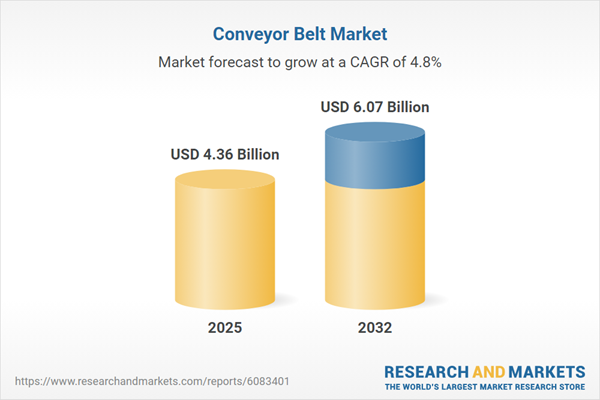Speak directly to the analyst to clarify any post sales queries you may have.
The conveyor belt market is advancing rapidly, propelled by industrial demand for efficient materials handling, increased automation, and evolving supply chain strategies. As operational leaders face new regulatory and technological requirements, selecting and managing the right conveyor belt systems is more critical than ever for operational resilience.
Market Snapshot: Conveyor Belt Market Size, CAGR & Growth
The Conveyor Belt Market grew from USD 4.16 billion in 2024 to USD 4.36 billion in 2025. It is expected to continue growing at a CAGR of 4.84%, reaching USD 6.07 billion by 2032. This robust expansion is fueled by the increasing integration of advanced materials, predictive maintenance solutions, and the modernization of manufacturing, logistics, and extraction operations worldwide.
Scope & Segmentation
- Material Types: Fabric (Nylon, Polyester), PVC (Hard, Soft), Rubber (Natural, Synthetic), Steel Cord
- End Use Sectors: Automotive, Food & Beverage, Logistics, Manufacturing, Mining
- Applications: Bulk Material Handling (Overland Conveyors, Troughed Belt Conveyors), Pallet Handling, Sortation, Unit Load Handling
- Conveyor Length Categories: 5 to 10M, Above 10M, Below 5M
- Belt Width Ranges: 500 to 1000 mm, Above 1000 mm, Below 500 mm
- Regions Covered: Americas (including United States, Canada, Mexico, Brazil, Argentina, Chile, Colombia, Peru), Europe, Middle East & Africa (including United Kingdom, Germany, France, Russia, Italy, Spain, Netherlands, Sweden, Poland, Switzerland, UAE, Saudi Arabia, Qatar, Turkey, Israel, South Africa, Nigeria, Egypt, Kenya), Asia-Pacific (China, India, Japan, Australia, South Korea, Indonesia, Thailand, Malaysia, Singapore, Taiwan)
- Company Coverage: Ammega Holding B.V., Bridgestone Corporation, Continental AG, Continental Belting Private Limited, Habasit AG, Mitsuboshi Belting Ltd., Nitta Corporation, Semperit AG Holding, The Goodyear Tire & Rubber Company, Trelleborg AB
Key Takeaways for Senior Decision-Makers
- Selection of conveyor belts must move beyond initial purchase cost, emphasizing material durability, lifecycle efficiency, and compatibility with predictive maintenance.
- Technological shifts such as modular designs and digital condition monitoring are raising operational expectations and contributing to greater system reliability.
- Procurement strategies increasingly require supplier diversification and dual-sourcing to minimize lead-time risks and adapt to trade uncertainties.
- Sustainability criteria, such as the recyclability of materials and energy-efficient drive systems, are transforming procurement priorities and regulatory compliance obligations.
- Regional service footprints, rapid technical support, and local production capabilities are key differentiators for vendors in response to complex global supply chains.
Tariff Impact on Conveyor Belt Procurement
Shifting tariff policies and trade barriers have prompted organizations to reassess supplier networks and buffer inventories for critical spares. Many buyers now qualify regional manufacturers and renegotiate contract terms for greater flexibility. This approach supports operational continuity and reduces exposure to cross-border cost fluctuations.
Methodology & Data Sources
This research leverages structured interviews with stakeholders such as procurement managers and reliability engineers, alongside technical consultations and secondary sources including industry standards and patent analysis. These data sources validate material performance and supply chain trends, ensuring actionable findings for decision-makers.
The Conveyor Belt Market: Why This Report Matters
- Enables procurement and operations leaders to benchmark supplier capabilities and assess the readiness of emerging technologies such as predictive maintenance.
- Provides region-specific insights, supporting strategic planning regarding inventory management, regulatory demands, and service model adaptations.
- Informs investment decisions that align lifecycle value, technical fit, and supply chain resilience in dynamic industrial environments.
Conclusion
Aligning material innovation, digital systems, and supplier service is essential for sustainable conveyor belt operations. This report offers the guidance needed for strategic specification and procurement that meets evolving operational demands.
Table of Contents
3. Executive Summary
4. Market Overview
7. Cumulative Impact of Artificial Intelligence 2025
Companies Mentioned
The companies profiled in this Conveyor Belt market report include:- Ammega Holding B.V.
- Bridgestone Corporation
- Continental AG
- Continental Belting Private Limited
- Habasit AG
- Mitsuboshi Belting Ltd.
- Nitta Corporation
- Semperit AG Holding
- The Goodyear Tire & Rubber Company
- Trelleborg AB
Table Information
| Report Attribute | Details |
|---|---|
| No. of Pages | 190 |
| Published | November 2025 |
| Forecast Period | 2025 - 2032 |
| Estimated Market Value ( USD | $ 4.36 Billion |
| Forecasted Market Value ( USD | $ 6.07 Billion |
| Compound Annual Growth Rate | 4.8% |
| Regions Covered | Global |
| No. of Companies Mentioned | 11 |









